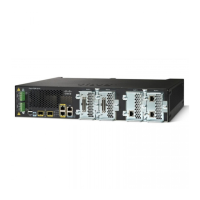10-18
Catalyst 3550 Multilayer Switch Software Configuration Guide
78-11194-09
Chapter 10 Configuring Interface Characteristics
Configuring Layer 3 Interfaces
Configuring Layer 3 Interfaces
The Catalyst 3550 supports three types of Layer 3 interfaces:
• SVIs: You should configure SVIs for any VLANs for which you want to route traffic. SVIs are
created when you enter a VLAN ID following the interface vlan global configuration command. To
delete an SVI, use the no interface vlan global configuration command.
Note When you create an SVI, it does not become active until it is associated with a physical port.
For information about assigning Layer 2 ports to VLANs, see Chapter 12, “Configuring
VLANs.”
• Layer 3 EtherChannel ports: EtherChannel interfaces made up of routed ports.
EtherChannel port interfaces are described in Chapter 30, “Configuring EtherChannels.”
• Routed ports: Routed ports are physical ports configured to be in Layer 3 mode by using the no
switchport interface configuration command.
Note A Layer 3 switch can have an IP address assigned to each routed port and SVI. The number of routed
ports and SVIs that you can configure is not limited by software; however, the interrelationship between
this number and the number of other features being configured might have an impact on CPU utilization
because of hardware limitations. For more information about feature combinations, see the “Optimizing
System Resources for User-Selected Features” section on page 7-27.
All Layer 3 interfaces require an IP address to route traffic. The following procedure shows how to
configure an interface as a Layer 3 interface and how to assign an IP address to an interface.
Note If the physical port is in Layer 2 mode (the default), you must enter the no switchport interface
configuration command to put the interface into Layer 3 mode. Entering a no switchport command
disables and then re-enables the interface, which might generate messages on the device to which the
interface is connected.
Beginning in privileged EXEC mode, follow these steps to configure a Layer 3 interface:
Command Purpose
Step 1
configure terminal Enter global configuration mode.
Step 2
interface {{fastethernet | gigabitethernet} interface-id}
| {vlan vlan-id} | {port-channel port-channel-number}
Enter interface configuration mode, and enter the
interface to be configured as a Layer 3 interface.
Step 3
no switchport For physical ports only, enter Layer 3 mode.
Step 4
ip address ip_address subnet_mask Configure the IP address and IP subnet.
Step 5
no shutdown Enable the interface.
Step 6
end Return to privileged EXEC mode.

